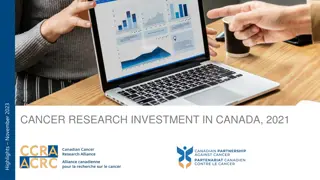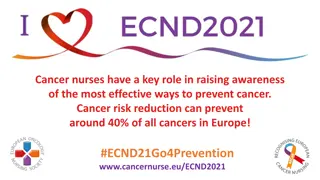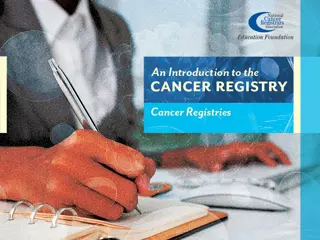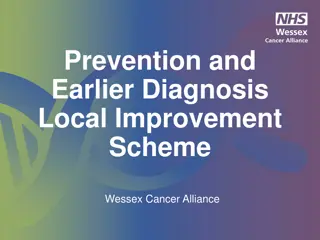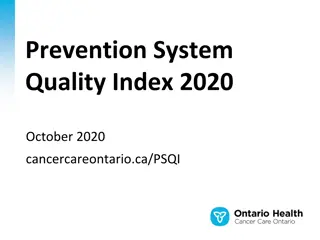Understanding Cancer: Causes, Symptoms, and Prevention
Cancer is a disease characterized by the uncontrollable growth and spread of abnormal cells in the body. These cells form tumors that can be either cancerous (malignant) or non-cancerous (benign). Cancer can develop in various parts of the body and is often caused by genetic changes that affect cell division. This article covers the basics of cancer, its formation, genes involved, uterine cancer specifically, symptoms, risks, prevention, and dietary recommendations during endometrial cancer.
Download Presentation

Please find below an Image/Link to download the presentation.
The content on the website is provided AS IS for your information and personal use only. It may not be sold, licensed, or shared on other websites without obtaining consent from the author. Download presentation by click this link. If you encounter any issues during the download, it is possible that the publisher has removed the file from their server.
E N D
Presentation Transcript
UTERINE CANCER AAMENA ZAIDI ASSISTANT PROFESSOR DEPARTMENT PF NUTRITION SCIENCE SCHOOL OF HEALTH SCIENCE
CONTENTS 1. WHAT IS CANCER 2. HOW DOES CANCER FORM 3. CANCER CAUSING GENES 4. ABOUT UTERUS 5. UTERINE CANCER 6. SYMPTOMS AND SIGNS 7. RISKS 8. PREVENTION 9. DIET DURING ENDOMETRIAL CANCER
UTERINE CANCER UTERINE CANCER
What is cancer cancer ? ? Cancer is a disease in which some of the body s cells grow uncontrollably and spread to other Cancer is a disease in which some of the body s cells grow uncontrollably and spread to other parts of the body. parts of the body. Cancer can start almost anywhere in the human body, which is made up of trillions of cells. Cancer can start almost anywhere in the human body, which is made up of trillions of cells. Normally, human cells grow and multiply (through a process called cell division) to form Normally, human cells grow and multiply (through a process called cell division) to form new cells as the body needs them. When cells grow old or become damaged, they die, and new cells as the body needs them. When cells grow old or become damaged, they die, and new cells take their place new cells take their place. Sometimes this orderly process breaks down, and abnormal or damaged cells grow and Sometimes this orderly process breaks down, and abnormal or damaged cells grow and multiply when they shouldn t. These cells may form tumors, which are lumps of tissue. multiply when they shouldn t. These cells may form tumors, which are lumps of tissue. Tumors can be cancerous or not cancerous Tumors can be cancerous or not cancerous (benign). Cancerous tumors spread into, or invade, nearby tissues and can travel to distant places in Cancerous tumors spread into, or invade, nearby tissues and can travel to distant places in the body to form new tumors (a process called metastasis). the body to form new tumors (a process called metastasis).
Cancerous tumors may also be called malignant tumors. Many cancers form solid tumors, Cancerous tumors may also be called malignant tumors. Many cancers form solid tumors, but cancers of the blood, such as leukemias, generally do not. but cancers of the blood, such as leukemias, generally do not. Benign tumors do not spread into, or invade, nearby tissues. When removed, benign Benign tumors do not spread into, or invade, nearby tissues. When removed, benign tumors usually don t grow back, whereas cancerous tumors sometimes do. Benign tumors tumors usually don t grow back, whereas cancerous tumors sometimes do. Benign tumors can sometimes be quite large, however. Some can cause serious symptoms or be life can sometimes be quite large, however. Some can cause serious symptoms or be life threatening, such as benign tumors in the brain. threatening, such as benign tumors in the brain.
How does cancer develop ? How does cancer develop ? Cancer is a genetic disease Cancer is a genetic disease our cells function, especially how they grow and divide. our cells function, especially how they grow and divide. that is, it is caused by changes to genes that control the way that is, it is caused by changes to genes that control the way Genetic changes that cause cancer can happen because Genetic changes that cause cancer can happen because: of errors that occur as cells divide. of damage to DNA caused by harmful substances in the environment, such as the chemicals in tobacco smoke and ultraviolet rays from the sun. they were inherited from our parents. The body normally eliminates cells with damaged DNA before they turn cancerous. But the The body normally eliminates cells with damaged DNA before they turn cancerous. But the body s ability to do so goes down as we age. This is part of the reason why there is a higher body s ability to do so goes down as we age. This is part of the reason why there is a higher risk of cancer later in life. risk of cancer later in life. Each person s cancer has a unique combination of genetic changes. As the cancer continues Each person s cancer has a unique combination of genetic changes. As the cancer continues to grow, additional changes will occur. Even within the same tumor, different cells may have to grow, additional changes will occur. Even within the same tumor, different cells may have different genetic changes different genetic changes
Types of genes that cause cancer Types of genes that cause cancer The genetic changes that contribute to cancer tend to affect three main types of genes The genetic changes that contribute to cancer tend to affect three main types of genes proto proto- -oncogenes, tumor suppressor genes, and DNA repair genes. These changes are oncogenes, tumor suppressor genes, and DNA repair genes. These changes are sometimes called drivers of cancer. sometimes called drivers of cancer. Proto Proto- -oncogenes oncogenes are involved in normal cell growth and division. However, when these are involved in normal cell growth and division. However, when these genes are altered in certain ways or are more active than normal, they may become genes are altered in certain ways or are more active than normal, they may become cancer cancer- -causing genes (or oncogenes) causing genes (or oncogenes) Tumor suppressor genes Tumor suppressor genes are also involved in controlling cell growth and division. Cells are also involved in controlling cell growth and division. Cells with certain alterations in tumor suppressor genes may divide in an uncontrolled with certain alterations in tumor suppressor genes may divide in an uncontrolled manner. manner. DNA repair genes DNA repair genes are involved in fixing damaged DNA. Cells with mutations in these are involved in fixing damaged DNA. Cells with mutations in these genes tend to develop additional mutations in other genes and changes in their genes tend to develop additional mutations in other genes and changes in their chromosomes, such as duplications and deletions of chromosome parts. Together, these chromosomes, such as duplications and deletions of chromosome parts. Together, these mutations may cause the cells to become cancerous. mutations may cause the cells to become cancerous.
Types of cancer Types of cancer There are more than 100 types of cancer. Types of cancer are usually named for the organs There are more than 100 types of cancer. Types of cancer are usually named for the organs or tissues where the cancers form. For example, lung cancer starts in the lung, and brain or tissues where the cancers form. For example, lung cancer starts in the lung, and brain cancer starts in the brain. Cancers also may be described by the type of cell that formed cancer starts in the brain. Cancers also may be described by the type of cell that formed them, such as an epithelial cell or a squamous cell. them, such as an epithelial cell or a squamous cell. Here are some categories of cancers that begin in specific types of cells: CARCINOMA CARCINOMA SARCOMA LEUKIMIA SARCOMA LEUKIMIA LYMPHOMA LYMPHOMA MULTIPLE MYELOMA MELANOMA MULTIPLE MYELOMA MELANOMA
About uterus The pear-shaped uterus is hollow and located in a woman s pelvis between the bladder and rectum. The uterus is also called the womb. It is where a baby grows when a woman is pregnant. The uterus has 3 sections: The cervix, which is the narrow lower section The isthmus, which is the broad section in the middle The fundus, which is the dome-shaped top section. The uterus is made up of 3 layers: the endometrium (inner layer), the myometrium (the thickest layer composed almost entirely of muscle), and the serosa (the thin outer lining of the uterus). During a woman's childbearing years, her ovaries typically release an egg every month, and the endometrium grows and thickens in preparation for pregnancy. If the woman does not get pregnant, this endometrial lining passes out of her body through her vagina, a process known as menstruation. This process continues until menopause, when a woman s ovaries stop releasing eggs
UTERINE CANCER Uterine cancer is the most common cancer occurring within a woman s reproductive system. Uterine cancer begins when healthy cells in the uterus change and grow out of control, forming a mass called a tumor. A tumor can be cancerous or benign. A cancerous tumor is malignant, meaning it can grow and spread to other parts of the body. A benign tumor can grow but generally will not spread to other body parts. Noncancerous conditions of the uterus include: Fibroids: Benign tumors in the muscle of the uterus Benign polyps: Abnormal growths in the lining of the uterus Endometriosis: A condition in which endometrial tissue, which usually lines the inside of the uterus, is found on the outside of the uterus or other organs Endometrial hyperplasia: A condition in which there is an increased number of cells and glandular structures in the uterine lining. Endometrial hyperplasia can have either normal or atypical cells and simple or complex glandular structures. The risk for developing cancer in the lining of the uterus is higher when endometrial hyperplasia has atypical cells and complex glands.
SYMPTOMS Some women with endometrial cancer have no symptoms until the disease has spread to other organs. But endometrial cancer is usually diagnosed by the appearance of symptoms -- like vaginal bleeding -- as the cancer begins to grow. The most likely symptoms are: Abnormal vaginal bleeding or discharge, which occurs in nine out of 10 women with endometrial cancer. Before menopause, this means unusually heavy irregular menstrual periods or bleeding between periods. After a woman enters menopause, this means any vaginal bleeding, unless they are on hormone replacement therapy (HRT). Even though HRT may cause vaginal bleeding in postmenopausal women, the first episodes of any such bleeding should be checked by a doctor to make sure that it is not due to endometrial cancer. However, only 15% of women with postmenopausal bleeding will have endometrial cancer. Vaginal discharge that may range from pink and watery to thick, brown, and foul smelling. Difficult or painful urination. An enlarged uterus, detectable during a pelvic exam. Pain during intercourse. Unexpected weight loss. Weakness and pain in the lower abdomen, back, or legs. This happens when the cancer has spread to other organs.
RISKS The following factors may raise a woman s risk of developing uterine cancer: Age. Uterine cancer most often occurs in women over 50. The average age at diagnosis is 60. Uterine cancer is not common in women younger than 45. Obesity. Fatty tissue in women who are overweight produces additional estrogen, a sex hormone that can increase the risk of uterine cancer. This risk increases with an increase in body mass index (BMI), which is the ratio of a person's weight to height. About 70% of uterine cancer cases are linked to obesity. Race. White women are more likely to develop uterine cancer than women of other races/ethnicities. However, Black women have a higher chance of being diagnosed with advanced uterine cancer. Black women and Hispanic women also have a higher risk of developing aggressive tumors. Genetics. Uterine cancer may run in families where colon cancer is hereditary. As explained in the Introduction, women in families with Lynch syndrome, also called hereditary non-polyposis colorectal cancer (HNPCC), have a higher risk for uterine cancer. It is recommended that all women under the age of 70 with endometrial cancer should have their tumor tested for Lynch syndrome, even if they have no family history of colon cancer or other cancers. The presence of Lynch syndrome has important implications for women and their family members. About 2% to 5% of women with endometrial cancer have Lynch syndrome. In the United States, about 1,000 to 2,500 women diagnosed with endometrial cancer each year may have this genetic condition. Read more about Lynch syndrome in a separate guide on this website. Diabetes. Women may have an increased risk of uterine cancer if they have diabetes, which is often associated with obesity.
Other cancers. Women who have had breast cancer, colon cancer, or ovarian cancer may have an increased risk of uterine cancer. Tamoxifen. Women taking the drug tamoxifen (Nolvadex) to prevent or treat breast cancer have an increased risk of developing uterine cancer. The benefits of tamoxifen usually outweigh the risk of developing uterine cancer, but all women who are prescribed tamoxifen should talk with their doctor about their personal benefits and risks. Radiation therapy. Women who have had previous radiation therapy for another cancer in the pelvic area, which is the lower part of the abdomen between the hip bones, have an increased risk of uterine cancer. Diet/nutrition. Women who eat foods high in animal fat may have an increased risk of uterine cancer. Estrogen. Extended exposure to estrogen and/or an imbalance of estrogen is related to many of the following risk factors: Women who started having their periods before age 12 and/or go through menopause later in life. Women who take hormone replacement therapy (HRT) after menopause, especially if they are taking estrogen alone. The risk is lower for women who take estrogen with progesterone, which is another sex hormone. Women who have never been pregnant.
PREVENTION Different factors contribute to different types of cancer. Researchers continue to investigate what factors cause uterine cancer, including ways to prevent it. Although there is no proven way to completely prevent uterine cancer, you may be able to lower your risk. Talk with your health care team for more information about your personal risk of cancer. Research has shown that certain factors can lower the risk of uterine cancer: Taking birth control pills. Birth control pills have a combination of estrogen and progesterone that are taken cyclically to produce a monthly menstrual period. This reduces the risk of an overgrowth of the uterine lining, especially when taken over a long period of time. Using a progestin-secreting intrauterine device (IUD), which is a form of birth control. Considering the risk of uterine cancer before starting HRT, especially estrogen replacement therapy alone. Using a combination of estrogen and progesterone for HRT may help lower risk. Maintaining a healthy weight, ideally a body mass index (BMI) less than 25. If you have diabetes, good disease management, such as regularly monitoring blood glucose levels, can lower your risk.
DIET DURING ENDOMETRIUM CANCER The following factors are under study for possible protective effects: Avoiding or reducing meat, dairy products, and saturated fat. The associations between meat and endometrial cancer have not been consistent; overall, case-control studies have identified increased risk of endometrial cancer associated with red meat in particular, a finding not reflected in most prospective studies.[24],[25] However, connections have emerged between components of meat (heme iron and saturated fat) and this cancer. The Swedish Mammography Cohort found significant relationships between both heme iron (found in both red and white meat) and liver consumption and endometrial cancer.[26] A dose-response analysis of fat intake and endometrial cancer concluded that increasing total fat intake by 10% of calories increased risk for this cancer by 5%. However, increasing saturated fat intake by 10g/1000 kcals was associated with a much greater risk (17%).[27] This implies that the effect of saturated fats on increasing risk for endometrial cancer is more than three times that of other types of fat. Previous research found that a higher fat intake, particularly saturated fat, was associated with elevations of endometrial cancer risk by approximately 60-80%.[9],[28] Dairy products may contribute to these effects, as shown in the Nurses Health study, which found a 40% greater risk for endometrial cancer in postmenopausal nonusers of hormone replacement therapy (HRT) who consumed 3 or more dairy servings per day, compared with those consuming less than 1.[29] Some evidence indicates that this association is due to the influence of dietary fat on adiposity and, consequently, on circulating estrogens.
Fruits, vegetables, and legumes. Although the NIH-AARP study found no significant relationship between fruit and vegetable intakes and endometrial cancer, previous studies suggested that these foods may be associated with reductions in risk by as much as 50-60%. A 2015 meta-analysis showed that a high soy intake is associated with a nearly 20% lower endometrial cancer risk. The reason may be that soy stops the conversion of other steroids like testosterone into estrogen, behaving as an aromatase inhibitor Avoidance of sugar and high glycemic-index carbohydrates. The Iowa Women s Health Study found a 78% greater risk for endometrial cancer in women who consumed the most sugar-sweetened beverages, compared to those who consumed the lowest amount. Other nutrition and lifestyle recommendations. Limiting high-energy-dense foods and high salt (or foods high in sodium), exercising regularly, and maintaining a healthy weight may reduce cancer risk. Following a plant-based diet helps achieve a healthy weight and provides a higher diet quality compared to other eating patterns.[40] There has been extensive research demonstrating that plant-based diets reduce the risk of other cancers such as breast, colorectal, and gastrointestinal cancers.[
BIBLIOGRAPHY WHAT IS CANCER & TYPES OF CANCER : cancermed.in UTERINE CANCER: www.cancer.gov.in UTERINE CANCER SIGNS SYMPTOMS PREVENTION: www.cancer.net SYMPTOMS: www.cancer.med DIET DURING UTERINE CANCER: nutritionguide.pcrm.org



